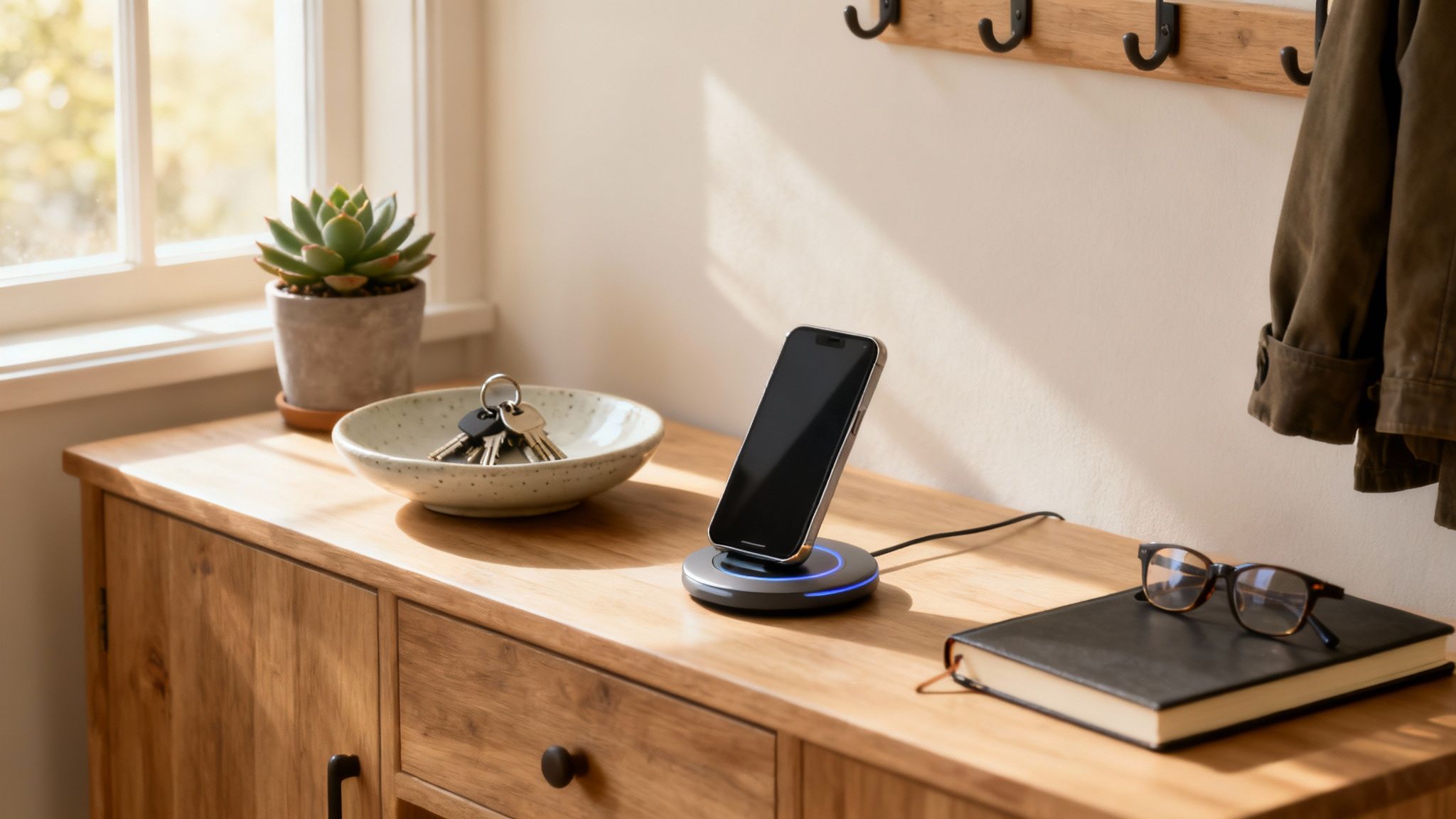Have you ever thought about how much time you spend on your phone each day? On average, adults in the United States spend about 30% of their time looking at their phones. Most people are awake for 15-16 hours each day, so that's almost five hours of daily screen time just from your phone. (Not including TVs, computers, etc.)
Now, some of those hours may be spent wisely, whether you're focusing on work tasks or engaging in important communications, but - be honest with yourself...
How much of that time is spent mindlessly scrolling?
Mindless scrolling can be a form of addictive behavior, raising concerns about the impact of cell phone use on mental health and productivity.
Let's look at what excessive scrolling can do to your brain, strategies for breaking the addiction, and tips for using smartphones purposefully.
Too long; didn't read
- Smartphones possess an addictive nature, mostly because they trigger the release of dopamine, the "pleasure and reward" brain chemical.
- Because people with ADHD likely have insufficient dopamine levels, they're especially susceptible to engaging in dopamine-seeking behaviors like mindless scrolling.
- Excessive smartphone use can lead to anxiety, the fear of missing out (FOMO,) and a heightened sensitivity to rejection.
- As discussed below in more detail, you can improve your relationship with technology by consciously setting rules and boundaries for yourself.
The link between mindless scrolling and ADHD
Mindless scrolling is a widespread problem because looking at your phone is downright addictive. But how did we get here? Why is this addiction happening?
In our brains, dopamine is produced and released as a "reward" when we do things like eating tasty food, exercising, or socializing. Dopamine offers pleasure and satisfaction when we engage in these activities, motivating us to repeat them.
Getting a quick dose of this "happy chemical" sounds great and all, but now that our smartphones provide endless dopamine opportunities with mindless scrolling — looking at you, TikTok and Instagram — we're even more susceptible to addiction.
Why your phone is addictive
Smartphones have the potential to trigger addictive tendencies due to their design and the various features they offer. The convenience and accessibility of smartphones, combined with their addictive design elements, can lead to compulsive and excessive use.
Here are some factors that keep you hooked on scrolling:
- Infinite scroll — New content automatically loads as you scroll, keeping you engaged and encouraging you to Keep. On. Scrolling.
- Push notifications — Ding! Your phone grabs your attention and creates a sense of urgency, making it difficult to resist checking your latest messages, which can easily spiral into mindless scrolling.
- Personalized content — Often coming from algorithms based on your preferences and online behavior, these recommendations keep you engaged by piquing your interests, leading to more screen time.
- Social validation — We all desire positive feedback and recognition, and social media platforms provide just that, one ‘Like’ at a time.
- Engaging animations and visual feedback — Have you ever gotten satisfaction from the sound Twitter makes when you refresh the feed? Or the heart bursts when you like someone's video on TikTok? These subtle interactions stimulate our senses, contributing to the addictive nature of smartphones.
- Ease of access — Where's your phone right now? Enough said.
- Controversial content — This includes anything that's polarized or has the potential to elicit a strong emotional response, namely news articles, social media posts, and the dreaded comment section. We become hooked due to the intense reactions it provokes.
4 ways your mindless scrolling habit is affecting your mental health
Dopamine might seem harmless at first. After all, feeling good is usually a good thing, right? But as the saying goes, having too much of a good thing can cause problems for your mental health.
1. Fear of missing out (FOMO)
The fear of missing out (FOMO) results from social media and other apps designed to create a sense of urgency, providing constant updates that can make you feel like you're missing out and will miss even more if you don't constantly refresh.1
Some apps even punish users for not checking their app frequently by giving them a less curated For You page. If you've tried to stay off socials for more than a few days, you might notice that apps don't immediately catch you up on what you missed.
This makes it harder to take any kind of lengthy social media break for fear of missing out.
More examples of FOMO:
- Not wanting to miss a sale or a "drop" for a product that has limited stock
- Trying to keep up with trends, the latest memes, TikToks, etc.
- Feeling like you absolutely must keep up with current events
2. Increased anxiety
The constant stimulation of social media can be overwhelming and overstimulating, which can lead to anxiety.
Social media can trigger negative self-comparison as we scroll through images and videos of models in great shape, influencers who wake up earlier and have amazing morning routines, or even people with nicer vacuums. It doesn't matter how minor it may seem; if you're left comparing yourself, you've already hit the anxiety phase of mindless scrolling: What am I doing wrong? Why am I the worst? I wish I had better things and a better life!
Social media apps and news outlets also tend to feed users controversial and negative content that can prompt an emotional stress response. This only leads to more anxiety and doom-scrolling, intensifying our pessimism and cynicism and giving us a "doomed" perspective on the world.
3. Rejection sensitive dysphoria (RSD)
Rejection sensitive dysphoria (RSD), an intense emotional response to real and perceived rejection and criticism, often goes hand-in-hand with mindless scrolling habits.
Constant exposure to other people's opinions on social media can lead to overwhelming feelings of rejection and anxiety. Some rejection is direct, especially for people who routinely post original content for an audience. For others, the rejection is indirect, leaving room for us to assume the worst about other people's intentions.
For example, it may be nice to follow accounts with the same interests or goals as you — you might feel validated or like you're part of a community. But what happens when those accounts are the ones subjected to criticism? Unfortunately, it can even cause ‘second-hand RSD’ by evoking deep feelings of hurt as if the criticism was aimed directly at you. 2
4. Worsened ADHD symptoms
While mindless scrolling itself doesn't cause ADHD, it can certainly exacerbate symptoms.
For example, suppose you, an ADHDer, are doing a boring task. How likely is it that you'll shift your attention to something more exciting — something that inherently makes you feel good?
Very likely.
Next thing you know, you're watching a video of unlikely animal friendships or discovering secret closet organization hacks.
In fact, research shows that people with ADHD have varying dopamine levels in different parts of the brain — some areas have too much dopamine, while others are in low supply.3 This suggests that the ADHD brain works overtime to balance dopamine levels. And, inevitably, when dopamine levels are low, the ADHD brain seeks alternative means, like eating something sweet or opening your favorite app.
Ready to break free from mindless scrolling? Inflow can help ADHDers understand their dopamine-seeking behaviors and even provide strategies and support to overcome them. Get started with Inflow today!
How to stop mindlessly scrolling
Set reasonable limits
Setting a time limit for your screen time may seem easy enough, but it can be even easier to disregard the pop-up notification: "You've reached your time limit on this app" and continue scrolling mindlessly anyway.
Set realistic expectations and take proactive steps to reduce your scrolling habit.
For instance, if you spend 3 hours on Instagram per day, set a limit of 2.5 hours instead. This reduction allows for a gradual transition and gives you a tangible goal to work towards.
However, merely cutting down on scrolling might leave you feeling a void or a sense of FOMO, so it's important to find alternative ways to spend your time—replacement hyperfixations, if you will.
Turn off notifications
"But what if there's an emergency?" Let's be honest with yourself about how often emergencies happen to you. Unless you're literally the President, an emergency room doctor on call, or a parent, you probably don't need to be notified of things immediately. Plus, you can always set exception rules for your nearest and dearest for peace of mind.
You can make a start by setting up a routine on your phone that turns notifications off at a certain time each night with the Do Not Disturb setting.
Find a new hobby
As mentioned, you might not be successful if you try to reduce your scrolling time without replacing that habit with something else.
Instead, pick up a new hobby. For a higher rate of success, pick a hobby that uses both of your hands, like crocheting, gaming, or sewing.
Create dedicated "phone-free" times
There are moments in the day when you just can't justify "needing your phone." In reality, it's just a habit, convenience, or your fear of missing out.
Here are some situations where this may apply:
- Watching a movie with your partner? You don't need your phone. (Unless, of course, you're down an IMDB rabbit hole because you can't figure out where you know that actor from and just need to know.)
- Getting ready for bed? You don't need your phone.
- Eating dinner? You really don't need your phone.
Instead of whipping out your phone, find more meaningful ways to spend your time during these dedicated "no-phone" hours, like catching up with your partner or friend, reading a book, or really savoring every bite of your meal.
Sources
1 Psychology Research and Behavior Management | Problematic Mobile Phone Use Increases with the Fear of Missing Out Among College Students: The Effects of Self-Control, Perceived Social Support and Future Orientation (2022)
2 New Media and Society | Social media is not real: The effect of 'Instagram vs reality' images on women's social comparison and body image (2019)
3 Reviews in the Neurosciences | Monoaminergic hypo- or hyperfunction in adolescent and adult attention-deficit hyperactivity disorder? (2021)







